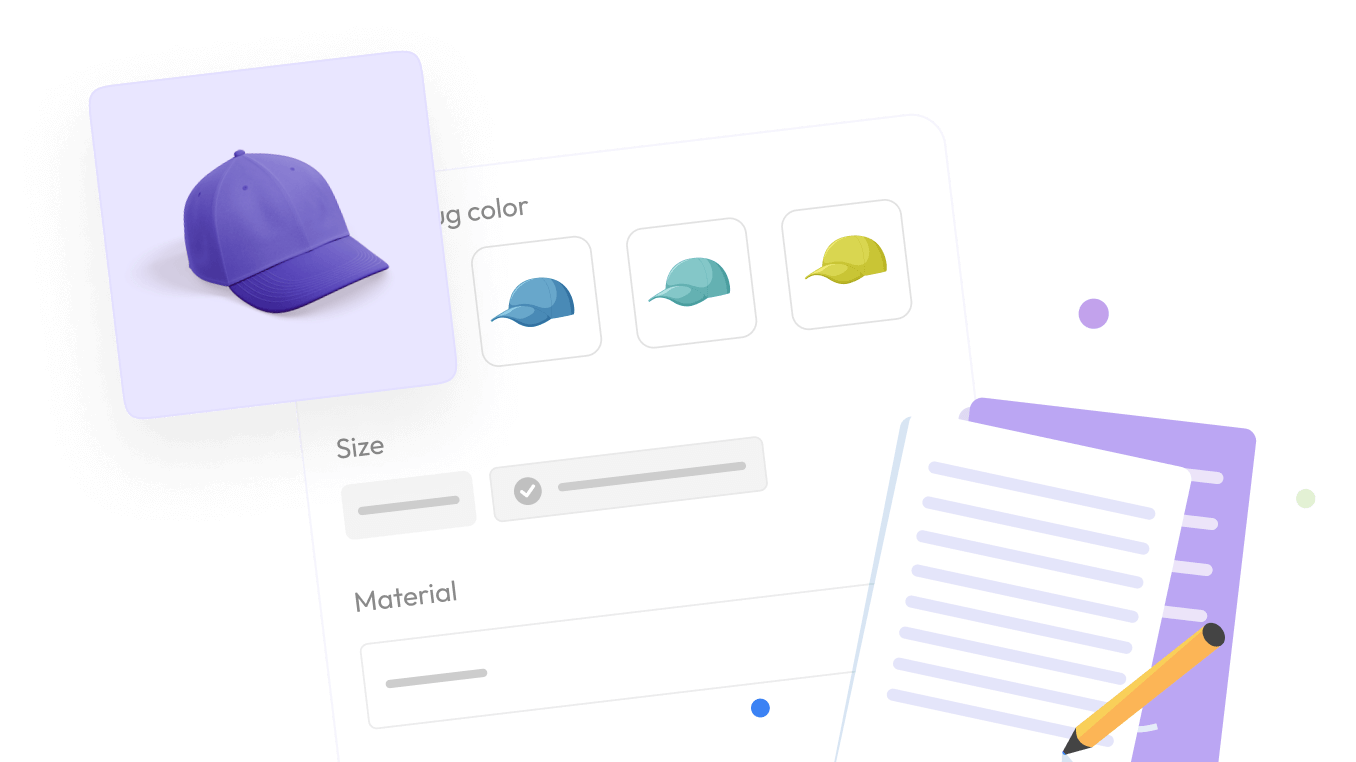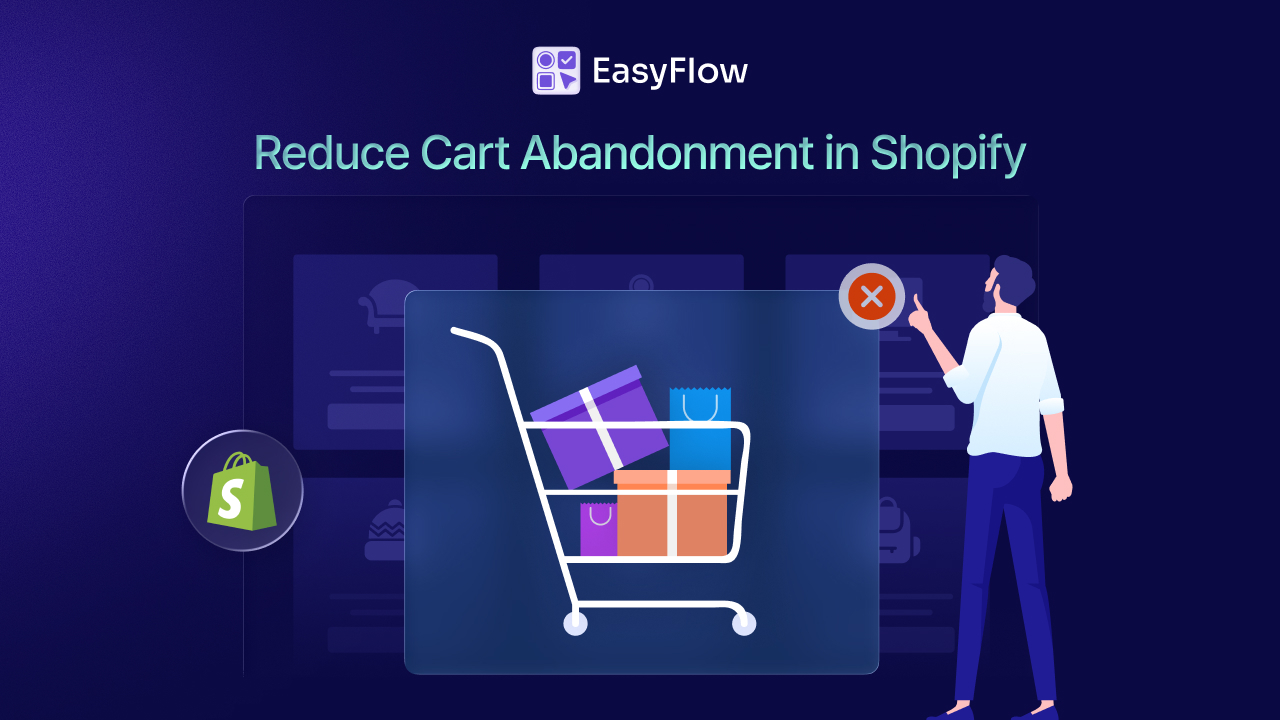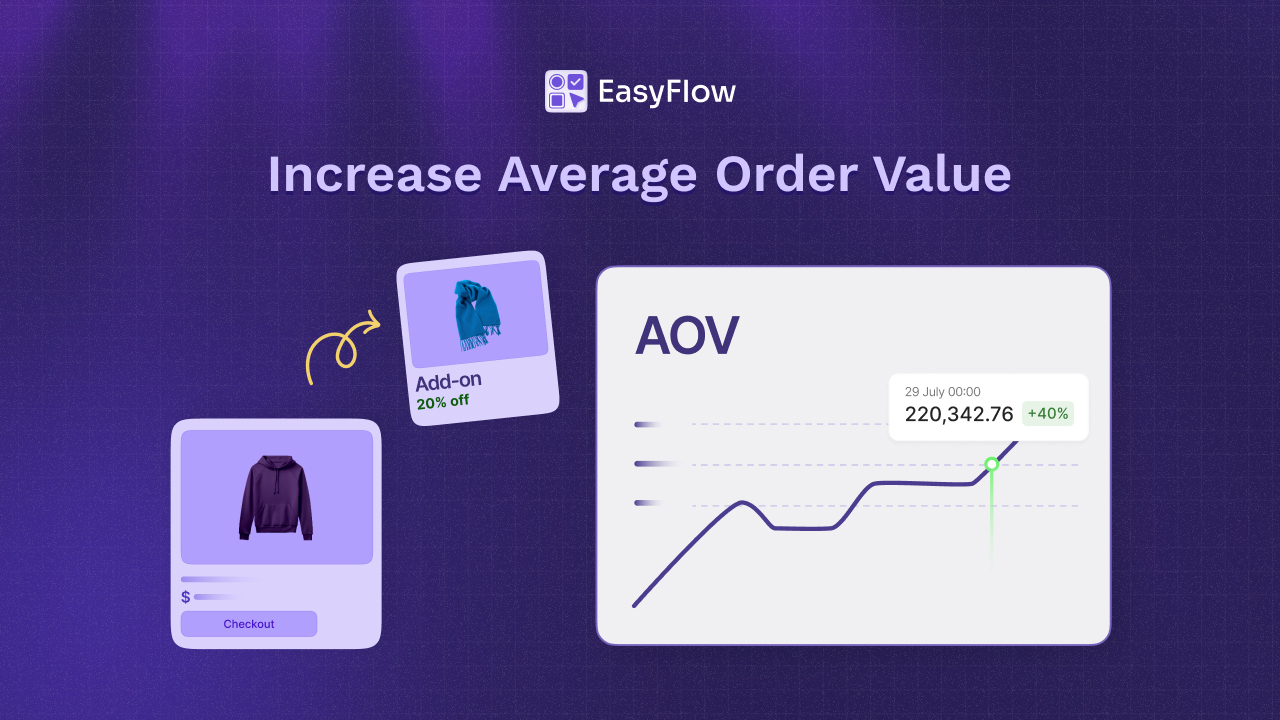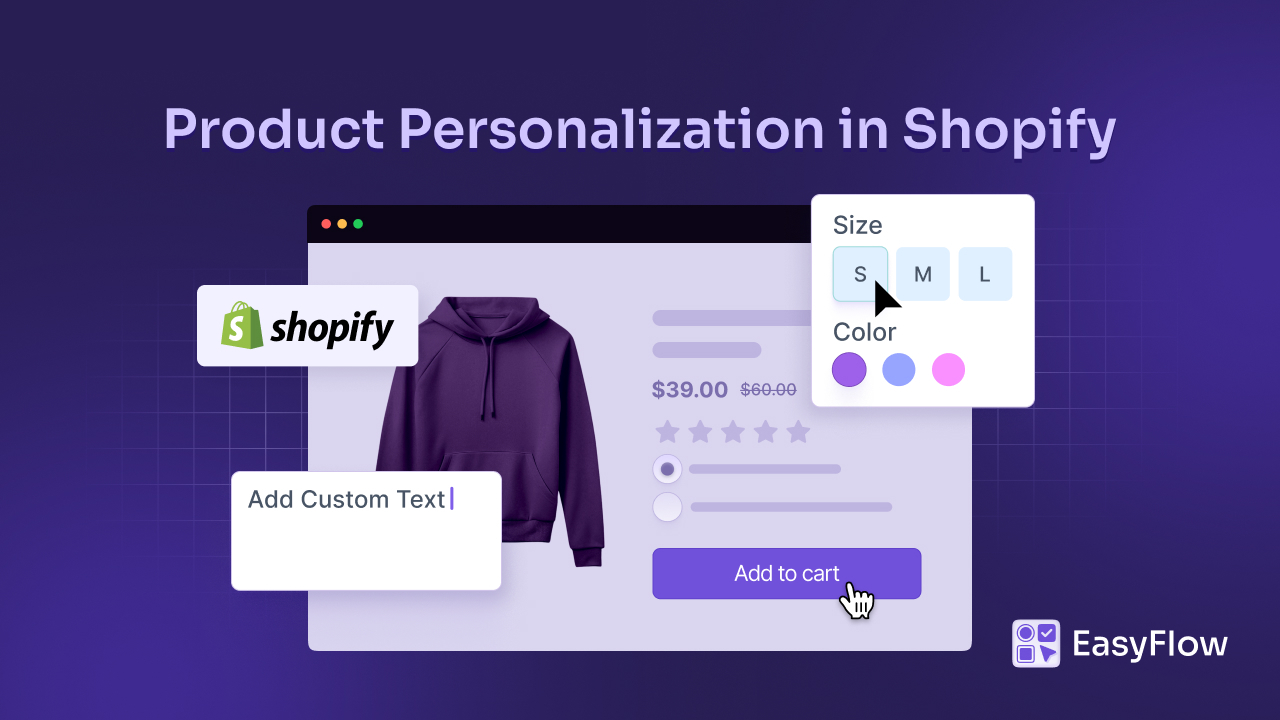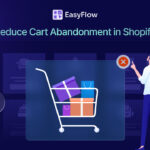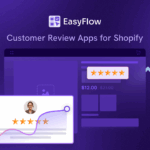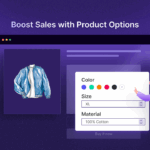Product customization has become a crucial part of modern eCommerce. It allows businesses to offer personalized experiences. This, in turn, drives customer satisfaction and increases sales. However, the path to successful product customization is not so smooth. Often, it encounters common pitfalls that can derail even the best intentions.

The good news is that these mistakes are entirely avoidable with the right approach and tools. EasyFlow, a comprehensive Shopify product customization app, addresses these challenges head-on by simplifying complex processes and automating time-consuming tasks. In this comprehensive guide, you will know the common product customization mistakes and see how EasyFlow’s innovative features can help you avoid them entirely.
What Is Product Customization in Shopify?
In Shopify, product customization means letting customers customize a product according to their preferences. It is beyond just selecting size or color. Shopify’s built-in variant system can handle basic options. However, product customization goes further. It can include,
- Personal text for engravings or gift messages
- File uploads for custom designs
- Complex pricing for add-ons
- Dependent option combinations
- Measurement collection for made-to-order items, or even
- Booking services alongside products.
At its core, customization transforms a standard “one-size-fits-all” store into an interactive experience. Instead of simply browsing fixed products, customers can create something unique that perfectly matches their preferences. This shift can have a big impact on business results.
Allowing customers to choose between multiple products often leads to happier customers, higher order values, stronger brand loyalty through emotional connection, and fewer returns because buyers are more satisfied with their purchase. It also sets your store apart, offering capabilities that others can not easily replicate.
However, offering advanced customization in Shopify has challenges. The platform works well for standard eCommerce, but it was not originally built to handle very complex customization. This can create a gap between what merchants want to offer and what Shopify can support without extra tools.
Take a custom apparel business as an example. They might need to manage precise body measurements, fabric choices with different prices, colors that affect availability, personalized text with character limits, special delivery instructions, and rush-order upgrades. Handling all these inputs while keeping pricing accurate and the shopping process smooth requires more sophisticated systems than Shopify provides out of the box.
Many merchants make mistakes by trying to stretch Shopify’s native tools too far or by using customization apps that do not fully meet their needs. Understanding these limitations and planning around them is the first step to creating a customization experience that works for both your business and your customers.

10 Common Product Customization Mistakes Shopify Store Owners Make
Many Shopify store owners struggle with complex setups, inconsistent pricing, and overwhelming product catalogs. These issues confuse rather than convert customers. Here in this section, first, we will explore the 10 most common product customization mistakes. You will also learn how EasyFlow can be a solution to those mistakes afterward.
Creating Separate Products for Every Variant Combination
One of the most prevalent product customization challenges is creating individual product listings for every possible variant combination. This approach can quickly become overwhelming, especially for businesses that offer many choices like size, color, material, and style.
A clothing retailer offering just five sizes, six colors, and three materials would need to create 90 separate product listings for a single item. This multiplication effect can cause serious issues for both store owners and shoppers. For example:
- Cluttered Shopify admin panel – making it hard to navigate and turning inventory management into a nightmare.
- Overwhelming shopping experience – customers struggle to find the exact combination they want among dozens of similar listings.
- Weakened search functionality – shoppers have to sift through multiple pages of what look like identical products before finding the right one.
From a customer perspective, research shows that 25-30% of online shoppers are interested in customization possibilities, but they abandon their search when faced with overwhelming choices presented as separate products.
Inconsistent Pricing Across Product Options
Pricing inconsistencies represent another common product customization mistake that can cost businesses both money and credibility. When you manage multiple product variants manually, it is easy for small pricing mistakes to slip in, such as errors in add-on costs, premium material charges, or customization fees. These issues can quickly multiply across a large inventory, resulting in serious consequences, including:
- Lost profits from underpricing products.
- Lost customers due to overpricing.
The challenge intensifies when dealing with complex pricing structures. Consider a custom jewelry business that charges different rates for various metals, gem types, engraving services, and rush orders. Manually calculating these combinations for every order not only consumes valuable time but also introduces multiple opportunities for human error. Customers notice these inconsistencies, and they can severely damage trust in your brand.
Time-Consuming Manual Setup Processes
The traditional approach to setting up product customization in Shopify is highly time-consuming, with store owners often spending hours creating individual variants, inputting pricing details, and configuring options for each product.
As inventory grows, this manual process becomes exponentially more complex, creating a bottleneck that limits scalability. The time drain does not stop after the initial setup. Every new product requires the same tedious process, and updating existing options means revisiting multiple products one by one. This inefficiency leaves business owners stuck in repetitive admin work instead of focusing on growth-driving activities such as,
- Marketing to attract and retain customers.
- Customer service to improving satisfaction and loyalty.
- Product development to expand offerings and stay competitive.
Lack of Reusable Components
Another common product customization mistake is recreating the same options repeatedly across different products. Many store owners manually enter identical size charts, color choices, or material selections for every single item, wasting hours on redundant work and increasing the risk of inconsistencies in the product catalog. This repetitive process is especially damaging for businesses with large inventories, such as:
- Fashion retailers are repeatedly adding the same size chart to dozens of products.
- Furniture companies are re-entering identical fabric or finish options across their entire catalog.
Over time, these inefficiencies compound, creating an unsustainable workload that only grows with every new product added.
Limited Customization Options Due to Platform Constraints
Shopify’s native customization capabilities are functional for basic needs. But this often falls short of what modern eCommerce businesses require. The platform’s built-in limitations can restrict your ability to offer comprehensive customization options, forcing you to choose between customer satisfaction and platform constraints. These limitations become particularly problematic for businesses in industries like fashion, jewelry, or custom manufacturing, where extensive customization is essential.
The frustration of hitting these limits often pushes store owners toward complex workarounds or costly custom development, which can introduce new challenges such as:
- Technical expertise requirements – needing specialized skills to implement and manage solutions.
- Ongoing maintenance – constant updates and troubleshooting to keep everything running smoothly.
- Higher risk of errors – more moving parts mean more potential points of failure.
In the end, many businesses are forced to compromise between the ideal shopping experience they want to provide and the limitations of the platform.
Poor User Experience During Customization
The customization process itself can become a significant barrier to sales if not properly designed. Customers encountering confusing interfaces, unclear options, or complicated selection processes often abandon their carts rather than complete purchases. The challenge is particularly acute when dealing with complex products that require multiple customization choices.
Poor user experience during customization can show up in several ways, such as unclear option descriptions, lack of visual feedback, complicated navigation between choices, and insufficient information for making informed decisions. These problems become even more damaging when customers can not easily see how their selections impact the final product or price, creating uncertainty that often leads to abandoned purchases. Common pain points include,
- Unclear descriptions that leave customers guessing about features or specifications.
- No visual feedback to show how choices change the product’s appearance.
- Complicated navigation makes switching between options frustrating.
- Missing pricing updates that prevent customers from understanding cost changes in real time.
Inadequate Input Collection for Custom Requirements
Many businesses struggle with collecting the specific information needed to fulfill custom orders. Whether it’s text for engraving, measurements for custom-fit items, or special instructions for personalized products, inadequate input collection leads to incomplete orders, customer frustration, and potential fulfillment errors.
The challenge extends beyond simply collecting information to organizing and managing it effectively. Text inputs, file uploads, date selections, and measurement specifications all require different handling approaches. Without proper systems in place, this information can easily become scattered or lost, leading to delays and errors in order fulfillment.
Failure to Utilize Cross-Selling Opportunities
Product customization presents excellent opportunities for cross-selling and upselling. However, many businesses fail to capitalize on these chances. Instead of using customization as a revenue driver, they treat it merely as a product feature, missing significant potential for increased average order values and enhanced customer satisfaction.
The mistake often stems from viewing customization options in isolation rather than as part of a broader sales strategy. Businesses focus solely on the primary product customization without considering complementary items, accessories, or service upgrades that customers might want to add to their orders. Nike’s customization program (NikeiD) has seen business triple since 2004, largely due to effective upselling during the customization process.
Ignoring Service-Based Product Requirements
Service-based businesses often struggle to adapt product customization tools to their unique needs. Unlike physical products, services require different types of input collection, such as appointment scheduling, service duration selection, and requirement gathering. Many customization solutions focus exclusively on physical products, leaving service providers without adequate tools.
This gap makes service-based businesses rely on workarounds or use several different tools to get the information they need, which adds extra complexity and increases the chances of mistakes. In the end, it often leads to a messy customer experience and more admin work.
Lack of Scalability in Customization Systems
One of the biggest long-term product customization mistakes is using a customization system that can not grow with your business. A setup that works fine for a small inventory with limited options can quickly become messy and hard to manage as you add more products and customization choices. When this happens, businesses often face costly migrations or complete system overhauls, right at the point when growth should be the priority.
The problem usually shows up only after a lot of time and money have already been spent on the original system. By then, you are left choosing between sticking with tools that no longer meet your needs or making an expensive, time-consuming switch. Common signs your system is not scaling include:
- Difficulty managing a growing inventory with more variants and options.
- Slower processes that eat up more time as your catalog expands.
- Frequent technical limitations that stop you from adding new features or improvements.
- High migration costs when switching to a better solution become unavoidable.
How EasyFlow Helps You Avoid Common Product Customization Mistakes?
In Shopify, you will find product variant options, but there is a limit. So, for advanced customization needs, you need a solution that does not have that. There are many product customization apps for Shopify. Among those, EasyFlow is one of the efficient product variant apps that you can use to address those common product customization mistakes.
Intuitive Admin Panel & User Experience
EasyFlow prioritizes user experience with its clean, intuitive interface that guides customers through the customization process seamlessly. Also, instead of creating separate products for every variant combination, merchants can use a single product listing with comprehensive options.
The app’s streamlined product option management feature enables you to present all choices in one location, streamlining your admin panel while significantly enhancing the customer shopping experience. A boutique selling dresses can offer multiple sizes, seasonal colors, and fabric options through just one product listing, making both management and shopping infinitely easier.
Auto Pricing Calculation for Addon Products
EasyFlow eliminates the mental math and potential errors associated with add-on costs through its automated pricing feature. The system handles all pricing calculations automatically, whether you are charging extra for premium materials, custom engravings, or special finishes. These costs integrate seamlessly into the customer’s cart total, ensuring accuracy every time and reducing the administrative burden on store owners. The automation means you can focus on growing your business rather than double-checking calculations.
Instant Configuration & Easy Set Up
EasyFlow makes the setup process simple and fast with its instant configuration capabilities. Merchants can create complete option sets in under a minute, compared to the hours traditionally required for manual setup. This dramatic time savings comes from EasyFlow’s intuitive interface that eliminates unnecessary steps and streamlines the entire process. Store owners simply name their option, add values, and they’re ready to go. The efficiency gain allows businesses to focus on growth rather than getting bogged down in setup procedures.
Reusable Option Sets

Instead of recreating the same size charts or color options for every product, you can design option sets once and apply them across multiple products instantly. EasyFlow addresses this inefficiency of repetitive work through its reusable option sets. A clothing retailer can create a single “Apparel Sizes” option set and use it for shirts, pants, jackets, and accessories without any additional setup time. This approach ensures consistency across your catalog while dramatically reducing setup time and maintenance requirements.
Unlimited Product Options

EasyFlow breaks through Shopify’s native limitations by providing unlimited product options and variants. If you are looking to go beyond basic platform restrictions, EasyFlow steps in as a powerful solution that helps you create unlimited product options and variants effortlessly. This flexibility allows businesses to offer truly comprehensive customization without being constrained by platform limitations, opening up new possibilities for customer engagement and satisfaction.
Flexible and Diverse Input Options
EasyFlow excels in handling diverse input requirements through its flexible input options. Whether you need text inputs for custom engravings, file uploads for personalized designs, or date selections for scheduled deliveries, EasyFlow manages these requirements seamlessly. Custom product businesses can streamline their personalization services, from custom jewelry with engraved names to personalized mugs with uploaded photos, all through structured, organized input collection systems.
Compelling Cross-Selling Opportunities

EasyFlow enables sophisticated cross-selling through its add-on product functionality. Bundle sellers can capitalize on these features to create compelling cross-selling opportunities. Electronics retailers can offer extended warranties, cases, and accessories as bundled options, while gift basket companies can allow customers to add specialty items or upgrade packaging through simple option selections. This approach transforms customization from a simple feature into a powerful revenue-generating tool.
Unique Service-Based Needs
EasyFlow recognizes the unique needs of service-based businesses. Service-based product businesses can benefit from EasyFlow’s input options, like Date Picker, File Upload, etc. Consultants can add appointment schedules, or service providers can gather necessary customer information through structured files, all within the same comprehensive system.
Scalability for Expanding Businesses
EasyFlow is designed with scalability at its core, supporting businesses as they grow from small operations to major enterprises. The app’s unlimited options capability, reusable components, and automated systems ensure that your customization infrastructure can expand seamlessly with your business. Whether you are adding new product lines, introducing additional customization options, or expanding into new markets, EasyFlow provides the robust foundation needed to support sustainable growth.
Fortify Your Shopify Product Customization Strategy & Boost Revenue
These 10 common product customization mistakes outlined above represent significant obstacles to successful product customization, but they are entirely avoidable with the right approach and tools. The key to avoiding these common mistakes lies in choosing solutions that prioritize both immediate functionality and long-term scalability.
EasyFlow addresses each of these challenges through thoughtful design and powerful automation, transforming product customization from a complex burden into a competitive advantage. The app’s comprehensive feature set addresses the needs of diverse business types, from fashion retailers and custom product businesses to bundle sellers and service providers.
Do not let these common pitfalls limit your business potential. With EasyFlow’s innovative approach to product customization, you can focus on what matters most: growing your business and satisfying your customers.
If you found this blog helpful, please subscribe for more expert guides, tutorials, and tips on unlocking the full potential of your Shopify store.


